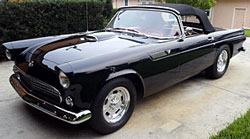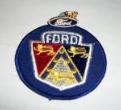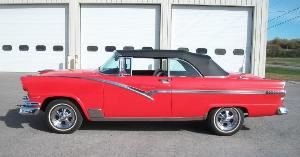|
Author
|
Message
|
|
Florida_Phil
|
|
|
Group: Forum Members
Last Active: 2 Years Ago
Posts: 1.2K,
Visits: 285.6K
|
The rear seal gets blamed for a lot of Y-Block leaks. The seal retainer, value covers, oil pump, pickup tube, front seal and oil pan are the usual culprits. I had what I thought was an engine oil leak that turned out to be a missing freeze plug in front of my manual transmission. I still have an occasional drop or two, but nothing serious enough to get excited about.

|
|
|
|
|
2721955meteor
|
|
|
Group: Forum Members
Last Active: Last Year
Posts: 927,
Visits: 190.0K
|
i hade my292 leaving oil that i thought the rear seal leaking.turned out it was valley cover,oil ran downriver side and caught on a spark plug wire,then oil pump cover and stuck on clutch cover which led me to the rear seal.,removed the clutch cover, dry no leak there. finally figured it out will pull the intake this winter and address the real problem
|
|
|
|
|
Tim Quinn
|
|
|
Group: Forum Members
Last Active: 4 Years Ago
Posts: 266,
Visits: 3.5K
|
Ted,
Sure wish that we had this very informative information a year ago.
We had same problem with rear main leak Replaced it (3) THREE times !!!
If we have to put the engine, rest assured that this procedure will be followed.
Tim
Central, FL 33706
|
|
|
|
|
Florida_Phil
|
|
|
Group: Forum Members
Last Active: 2 Years Ago
Posts: 1.2K,
Visits: 285.6K
|
What an informed and interesting read. I have never seen a Y Block that didn't leak some amount of oil from the rear seal until I rebuilt my 292 last summer. I used Ted's method and it worked great. I did have a leak, but it turned out to be a bad oil pump, not the seal. The floor in my garage is now dry. I used the black plastic seal that came with the FelPro gasket set I bought when I rebuilt my engine. The instructions on the seal package were "WRONG". They said to install the side seal nails on the block side of the retainer. I installed them as Ted described and no leaks. Thanks TED!!

|
|
|
|
|
Cactus
|
|
|
Group: Forum Members
Last Active: 5 Years Ago
Posts: 229,
Visits: 30.2K
|
Thank youTed, I will give this thing one more try using your steps.
  Jan Urbanczyk Major USMC Ret. Jan Urbanczyk Major USMC Ret. Bowie Maryland
|
|
|
|
|
KULTULZ
|
|
|
Group: Forum Members
Last Active: 2 Weeks Ago
Posts: 1.8K,
Visits: 306.3K
|
I'm gonna tell you one thing- If I ever again need engine machining/assembly work, I will trailer the engine to Waco. I can wait across the border in BOYS-TOWN while he does the work. Do you do all FORD engines Ted? I would love to see your shop before I croak.
____________________________
|
|
|
|
|
oldcarmark
|
|
|
Group: Forum Members
Last Active: 2 Weeks Ago
Posts: 3.7K,
Visits: 32.6K
|
Ted (5/19/2019)
The 312 crankshafts are notorious for having pitted seal surfaces on those crankshafts. This comes from many of those cars sitting in non-climate controlled areas for extended periods of time and condensation eroding the crankshaft seal surfaces. On those, I have been able to grind the crankshaft seal surfaces down 0.010” and still not have a problem when using the rubber seals. 312 rubber rear main seals are different from the 292 seals and are not interchangeable. I have successfully installed those crankshafts with the oil slingers missing and/or machined off with zero leaks. My ’55 Ford with its 272 came from the factory without that slinger and there’s no groove in the block to accommodate a slinger style of crankshaft if I had wanted to install a later model crankshaft. The 312 crankshaft in my 337” Y in my roadster had the slinger machined off at the time due to not having a narrow stone. No oil leaks on that engine either but I use neoprene rear seals and not rope seals on all Y’s. I was recently involved with a neighboring city with a ’57 Ford Police car that is now only used for parade duty. They had the 292 engine recently rebuilt by a shop in a neighboring city and while the engine ran good, it was a oil leaker at the rear of the engine. That City Garage pulled that engine twice more and took it back to the shop that performed the engine rebuild but each time it was reinstalled, it leaked profusely at the rear. The first time the engine was put together it was with a rope seal and the next two times, the neoprene or rubber seals were used. I sold the shop the Best Gasket neoprene seal set for the third go around as they are grabbing for reasons that the engine continues to leak oil each time it’s reinstalled. At this point, the seals themselves are being blamed. The City Garage put a dye in the oil after that third go around and with a black light determined that it was indeed the main seal and not the side seals or any other spot in that general area. At this point, I’m contacted to see if I can look at the engine and determine what’s going on. The shop is ready to install another crankshaft if necessary. With the engine in my shop and upside down on an engine stand, the oil pan is removed. The mechanic from that City Garage is present and is helping. He is intimately involved with this engine at this point being the mechanic that has to pull it from the car each time it’s being worked on. While the back of the engine is oily, the side seals look good. With the crankshaft being rotated, there is oil weeping from the rear seal area so the leak is bad. The seal retainer is removed and when the crankshaft is rotated, there is an obvious trail of oil coming up around the crankshaft in alignment with the half of the rear seal that’s still in place in the block. Careful removal of the rear seal half in the seal retainer finds that the seal was liberally coated with RTV. That’s a big no no. The seal half in the block is rotated out of the block by putting some pressure on one end of the seal with a small bladed screwdriver while the crankshaft is rotated. While there’s not a lot of RTV present in the block groove, there is RTV present but of bigger concern is the RTV that has dried and hardened on the seal surface of the crankshaft. Some careful cleaning with emory cloth on both the crankshaft seal surface and the groove in the block, everything is deemed good enough to reassemble the back end of the engine. There’s a considerable amount of time spent in cleaning up that residual RTV from where there should have been no RTV present. Using another new Best Gasket rear seal kit, I liberally coat the crankshaft rear seal half with white grease and slide that seal in the groove so that about 3/8” is sticking up on one end. A dab of Copper Coat sealer is installed on both the flat of the block where the retainer rests and the bottom of the retainer where it contacts the block. The retainer half of the seal is then liberally coated with white grease and installed in the retainer groove so that the seal offset matches that in the block. There is one last and final check of both seal halves to insure that the seal lips are to the inside of the motor and not reversed. The retainer is then placed in the block. It’s pulled down so that it is about 1/16”-1/8” from being mated to the block. A dab of black RTV is put into each side seal hole and then the rubber side seals are slid down so that they are sitting about 3/8” above the oil pan gasket surface. To aid putting the side seals in place, a small bladed screwdriver is used to pry the side seal over to give the side seal more room to slide down freely in the groove. This is performed on both sides of the retainer. With the nails put in the retainer side of the rubber seals, they are tapped in place with a hammer while some downward pressure is applied to the rubber seals while driving the nails in place. With the side seals down, the rear seal retainer is pulled down and tightened. The tell tale signs of the RTV being squeezed out at the bottom corners of the retainer is evident meaning I have RTV right where it needs to be. The previous engine shop that had installed the rear seals had also been liberal with some kind of nasty glue on the oil pan gasket which required some serious cleaning on both the pan and the block. With all that cleaned off, the new Best Gasket oil pan gasket (black fibrous material) was liberally coated with white grease and put in place. A new rubber oil pump seal is also coated with white grease and installed on the oil pickup tube. The oil pan bolts and oil pump inlet nut are tightened. Job done and took about two hours total. The mechanic goes back to the City Garage and reinstalls the engine. He calls back two days later and is happy to report that the oil leak problem is fixed. To my relief, no oil leaks what so ever after allowing the engine to run a full two hours on a car lift. The car is now ready for parade duty. Great Info Ted. I bet that Mechanic at the City Garage is now an Expert at Re+Re Y-Block Engines.
 
|
|
|
|
|
Ted
|
|
|
Group: Administrators
Last Active: Yesterday
Posts: 7.5K,
Visits: 205.9K
|
The 312 crankshafts are notorious for having pitted seal surfaces on those crankshafts. This comes from many of those cars sitting in non-climate controlled areas for extended periods of time and condensation eroding the crankshaft seal surfaces. On those, I have been able to grind the crankshaft seal surfaces down 0.010” and still not have a problem when using the rubber seals. As a side note, 312 rubber rear main seals are different from the 292 seals and are not interchangeable. I have successfully installed those crankshafts with the oil slingers missing and/or machined off with zero leaks. My ’55 Ford with its 272 came from the factory without that slinger and there’s no groove in the block to accommodate a slinger style of crankshaft if I had wanted to install a later model crankshaft. The 312 crankshaft in my 337” Y in my roadster had the slinger machined off at the time due to not having a narrow stone. No oil leaks on that engine either but I use neoprene rear seals and not rope seals on all Y’s. I was recently involved with a neighboring city with a ’57 Ford Police car that is now only used for parade duty. They had the 292 engine recently rebuilt by a shop in yet another neighboring city and while the engine ran good, it was a oil leaker at the rear of the engine. That City Garage pulled that engine twice more and took it back to the shop that performed the engine rebuild but each time it was reinstalled, it leaked profusely at the rear. The first time the engine was put together it was with a rope seal and the next two times, the neoprene or rubber seals were used. I sold the shop the Best Gasket neoprene seal set for the third go around as after that second seal installation they are grabbing for reasons that the engine continues to leak oil each time it’s reinstalled. At this point, the seals themselves are being blamed. The City Garage put a dye in the oil after that third go around and with a black light determined that it was indeed the main seal and not the side seals or any other spot in that general area. At this point, I’m contacted to see if I can look at the engine and determine what’s going on. The shop is ready to install another crankshaft if necessary. With the engine in my shop and upside down on an engine stand, the oil pan is removed. The mechanic from that City Garage is present and is helping. He is intimately involved with this engine at this point being the mechanic that has to pull it from the car each time it’s being worked on. While the back of the engine is oily, the side seals look good. With the crankshaft being rotated, there is oil weeping from the rear seal area so the leak is bad. The seal retainer is removed and when the crankshaft is rotated, there is an obvious trail of oil coming up around the crankshaft in alignment with the half of the rear seal that’s still in place in the block. Careful removal of the rear seal half in the seal retainer finds that the seal was liberally coated with RTV. That’s a big no no. The seal half in the block is rotated out of the block by putting some pressure on one end of the seal with a small bladed screwdriver while the crankshaft is rotated. While there’s not a lot of RTV present in the block groove, there is RTV present but of bigger concern is the RTV that has dried and hardened on the seal surface of the crankshaft. Some careful cleaning with emory cloth on both the crankshaft seal surface and the groove in the block, everything is deemed good enough to reassemble the back end of the engine. There’s a considerable amount of time spent in cleaning up that residual RTV from where there should have been no RTV present. Using another new Best Gasket rear seal kit, I liberally coat the crankshaft rear seal half with white grease and slide that seal in the groove so that about 3/8” is sticking up on one end. A dab of Copper Coat sealer is installed on both the flat of the block where the retainer rests and the bottom of the retainer where it contacts the block. The retainer half of the seal is then liberally coated with white grease and installed in the retainer groove so that the seal offset matches that in the block. There is one last and final check of both seal halves to insure that the seal lips are facing to the inside of the motor and not reversed. The retainer is then placed in the block. It’s pulled down so that it is about 1/16”-1/8” from being mated to the block. A dab of black RTV is put into each side seal hole and then the rubber side seals are slid down so that they are sitting about 3/8” above the oil pan gasket surface. To aid putting the side seals in place, a small bladed screwdriver is used to pry the side seal over to give the side seal more room to slide down freely in the groove. This is performed on both sides of the retainer. With the nails put in the retainer side of the rubber seals, they are tapped in place with a hammer while some downward pressure is applied to the rubber seals while driving the nails in place. With the side seals down, the rear seal retainer is pulled down and tightened. The side seals are tapped on once more to insure that they are down as far as possible. The tell tale signs of the RTV being squeezed out at the bottom corners of the retainer is evident meaning I have RTV right where it needs to be. The previous engine shop that had installed the rear seals had also been liberal with some kind of nasty glue on the oil pan gasket which required some serious cleaning on both the pan and the block. With all that cleaned off, the new Best Gasket oil pan gasket (black fibrous material) was liberally coated with white grease and put in place. A new rubber oil pump seal is also coated with white grease and installed on the oil pickup tube. The oil pan bolts and oil pump inlet nut are tightened. Job done and took about two hours total. The mechanic goes back to the City Garage and reinstalls the engine. He calls back two days later and is happy to report that the oil leak problem is fixed. To my relief, no oil leaks what so ever after allowing the engine to run a full two hours on a car lift. The car is now ready for parade duty.
  Lorena, Texas (South of Waco) Lorena, Texas (South of Waco)
|
|
|
|
|
Cactus
|
|
|
Group: Forum Members
Last Active: 5 Years Ago
Posts: 229,
Visits: 30.2K
|
I had a pcv and breathers on both valve covers and still leaked. I may just have to go back to a 292,. And to answer the question, it has been impossible for me to tell where it is coming from.
  Jan Urbanczyk Major USMC Ret. Jan Urbanczyk Major USMC Ret. Bowie Maryland
|
|
|
|
|
oldcarmark
|
|
|
Group: Forum Members
Last Active: 2 Weeks Ago
Posts: 3.7K,
Visits: 32.6K
|
Do You think its the actual Crankshaft Seal itself that is leaking or the Side Seals? Just Curious.
 
|
|
|
|